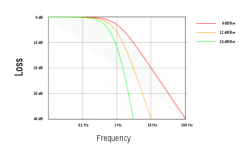Hi I looked around and couldnt find an answer to this newbie question. Suppose
I'm biamping a speaker with a tweeter that has a 2500hz high pass crossover. Would the amplifier have to work to produce the frequencies that the crossover cuts off? Or would the amplifier only "see" frequencies above 2500hz?
I'm biamping a speaker with a tweeter that has a 2500hz high pass crossover. Would the amplifier have to work to produce the frequencies that the crossover cuts off? Or would the amplifier only "see" frequencies above 2500hz?
It depends on the 'slope' of the crossover. With a first order filter slope, 6dB/octave, the level rolls of with decreasing frequency by 6 dB per octave, and at the xover frequency the level is down to 0.7 times.
With a 2nd order xover, which rolls of at 12dB per octave with falling frequency, at the xover freq, the level is 0.5x down.
Xover filters are never brick wall, but roll off gradually, the steepness of rolloff depends on the order of the crossover filter.
The higher order the filter, the steeper the roll off (and the more complex the filter!).
The example shown is a low pass but hi pass is the same, flipped around.
Jan
With a 2nd order xover, which rolls of at 12dB per octave with falling frequency, at the xover freq, the level is 0.5x down.
Xover filters are never brick wall, but roll off gradually, the steepness of rolloff depends on the order of the crossover filter.
The higher order the filter, the steeper the roll off (and the more complex the filter!).
The example shown is a low pass but hi pass is the same, flipped around.
Jan
Attachments
Last edited:
Hi! Right I get that part about slopes, but it still doesnt explain if the amplifier has to work to produce say 150hz at full power just so that the crossover can waste that power.
OK I get it. The answer is that the amp just reproduces what is thrown at it at the input, full range. But if the frequency is, in this case below, the cut off frequency, the xover filter sort of 'blocks' the signal going to the tweeter.
So yes, the amp reproduces the full range, but at the lower blocked frequencies the tweeter looks like a much higher impedance (because of the crossover) so the load on the amp for that blocked frequency is much lower.
Staying with the earlier mentioned slopes, at the cross over for the 1st order, the tweeter 'looks' like it has twice its impedance, and rising with lower frequencies.
With the 2nd order, at the xover freq, the tweeter 'looks' like 4 times its impedance and rising with lower freqs.
Now I must confess that this is not the whole story, because it is only valid for series xover filters. You also can have parallel xover filters (or combinations of the two) and these present also an impedance to ground that the amp has to drive.
The best way to evaluate a cross over in this respect is to simulate it and check the impedance over freq with a nominal speaker load.
Jan
So yes, the amp reproduces the full range, but at the lower blocked frequencies the tweeter looks like a much higher impedance (because of the crossover) so the load on the amp for that blocked frequency is much lower.
Staying with the earlier mentioned slopes, at the cross over for the 1st order, the tweeter 'looks' like it has twice its impedance, and rising with lower frequencies.
With the 2nd order, at the xover freq, the tweeter 'looks' like 4 times its impedance and rising with lower freqs.
Now I must confess that this is not the whole story, because it is only valid for series xover filters. You also can have parallel xover filters (or combinations of the two) and these present also an impedance to ground that the amp has to drive.
The best way to evaluate a cross over in this respect is to simulate it and check the impedance over freq with a nominal speaker load.
Jan
Last edited:
Ah, ok awesome. Yeah reason I wanted to know is Im thinking of using a tube amp on just the tweeter of a 3 way triamped speaker. Due to the first couple watts being high biased into class A I suppose if I use an inline FMOD crossover at around 1000+hz I can get more class a goodness out of it
